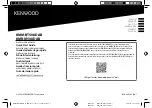
BARRETT 2030 HF SSB TRANSCEIVER
203 of 208
Overview of HF Operation
HF (High Frequency) is the radio spectrum with frequencies between 1.6 and 30
MHz. Within this radio spectrum an efficient form of transmitter modulation, SSB
(Single Side Band), is used. This, combined with the use of the ionosphere - a layer
of ionisation gases that resides between 100 and 700km above the earth’s surface,
provides efficient, cost effective communications over short, medium and long
distances - without the need for expensive re-transmission devices, such as the
VHF or UHF repeaters or satellites, all of which have ongoing operational costs and
a reliance on a physical infrastructure.
In many remote areas, HF/SSB is the only form of communication possible.
HF Propagation
When HF/SSB radio waves are generated by the transceiver there are usually two
components:-
-
The ground-wave, which travels directly from the transmitting antenna to the
receiving antenna following the contours of the earth
-
The sky-wave, which travels upward and at an angle from the antenna, until
it reaches the ionosphere (an ionised layer high above the earth’s surface),
is refracted back down to earth, to the receiving antenna
Generally speaking, ground-wave is used to communicate over shorter distances
usually less than 50km. Because ground-wave follows the contours of the earth, it
is affected by the type of terrain it passes over. Ground wave is rapidly reduced in
level when it passes over heavily forested areas or mountainous terrain.
Sky-wave is used to communicate reliably over medium to long distances up to
3,000 km. Whilst the nature of sky-wave propagation means it is not affected by the
type of terrain as in ground waves it is affected by factors involving the ionosphere
as described below.






































